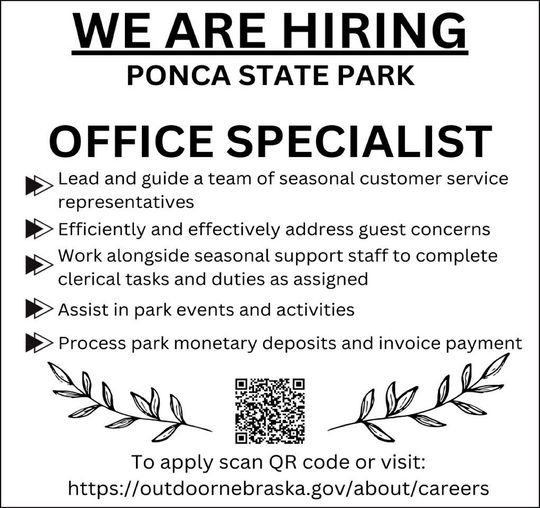WAUSA – A recent board discussion about Wausa Public Schools partnering with Osmond Community Schools on a junior high basketball cooperative agreement turned into a larger conversation about the future of the rural districts.
Members of the Wausa board of education discussed future planning at their regular meeting May 13, including a formal request from Osmond school officials to form a cooperative agreement with Wausa for junior high boys and girls basketball for the 2024-25 academic year.
This request has been made by Osmond because that school district’s junior high basketball teams will not have adequate numbers to allow Osmond to have junior high teams that can play competitive games or improve skills in practice.
According to a letter from the Osmond school board to the Wausa school board, a recent study of parents and patrons of the Osmond community has shown an overwhelming support for the Osmond school district to work toward a longterm partnership with the Wausa school district.
Osmond school officials believe that “a junior high basketball cooperative agreement will strengthen the partnership between both schools by showing a willingness to work together to ensure both schools can offer quality activities to their students,” according to the letter.
“The Osmond board of education and administration look forward to working with you and your school in regard to a junior high girls and boys basketball agreement for the 2024-25 school year as we envision both schools working together to development long-term partnerships in academics and activities to maintain stability in both of these great schools,” the letter concluded.
Wausa school board members took no action on the topic, but they likely will consider taking action on Osmond’s proposal for a one-year junior high basketball cooperative agreement during their regular meeting at 8 p.m. June 10.
An informational meeting on the potential cooperative agreement has been scheduled for 8 p.m. June 2 inside the commons area at Wausa Public Schools for parents of junior high students.
The meeting is not mandatory, and following the event, a survey is set to be emailed to parents of junior high students – regardless of whether they went to the meeting or not – about their interest in this proposed partnership.
The conversation about another potential cooperative agreement between Wausa and Osmond – they already are partnering on wrestling, football and FFA/agriculture starting in 2024-25 for four years – led to a deeper discussion at the Wausa school board meeting about future planning between the school districts.
Wausa Superintendent Brad Hoesing asked members of the school board’s future planning committee – Board President Mike Kumm and board members Katie Clausen and Derek Cunningham – to lead the discussion.
“In regards to the conversations around what we’ve got in place already with the co-op, we’d like to see how that works before we jump much farther,” Cunningham said.
He noted in those same conversations, the question came up of whether long-term cooperative agreements were the most feasible “thing to be doing or are there bigger conversations that need to be had for stability of the district financially, as well as enrollment?”
“Are there some other things that maybe we should be talking about alongside of co-oping?” Cunningham said. “We’re currently in a pretty healthy spot.” Clausen noted these kinds of conversations are not always “pleasant.”
“It’s not always something anybody has to love being up against,” she said. “By the time this year’s kindergartners are seniors in high school, there will only be 37 kids in the high school. Is that feasible for us? Thirty-seven kids – ninth-12th grade.”
Wausa had nearly 80 high school students in grades 9-12 for the 202324 academic year.
Clausen said she dug a little bit deeper into data for this discussion.
“We aren’t the only community that’s in this position,” she said.
Clausen noted the community of Wausa’s birth rate, according to the U.S. Census Bureau, is 2.9 percent.
“That is less than half of the state of Nebraska’s birth rate,” she said. “The median age of a person living in our community is 47, which is five years older than Knox County alone.”
Clausen shared information about the county’s population history.
“In the 1930s and the 1940s – when these schools were literally being built and things were changing from going to the one-room schoolhouses, the country schools – the population of Knox County was over 19,000 people,” Clausen said. “Today, it’s at (about) 8,200.
“From 2020 to 2024, Knox County has lost, on average, 100 people per year,” she said. “I would be really hard-pressed to believe that these statistics don’t touch all of rural America. Things are changing, and they’re changing a lot faster than we would hope.”
Clausen described Wausa’s next kindergarten class as “kind of the benchmark that we’re using just because that’s technically your first year of school. It’s not the pre-K program; it’s kindergarten.”
She explained Wausa business owners and community organizations “need to be cognizant of this,” referring to the population decrease both the community and the county have been experiencing in recent years.
“If we’re going to be attractive, it’s going to take quite a bit for our community to showcase ourselves,” Clausen said.
Kumm agreed. “Rural Nebraska in general probably reflects the same data,” he said. “When you’re looking at a statewide average, you know that the growth is being driven by larger (urban) environments.”
Kumm referred to the Omaha suburb of Gretna and the former community of Elkhorn that the city of Omaha annexed nearly 20 years ago.
“Population growth is what skews the average up, but I wouldn’t think that Verdigre or Niobrara or Crofton – almost every community that’s a (Class) D1 school on down is probably staring at the exact same kind of data,” he said. “We’ve all got to find a path forward.”
Clausen recalled a part of the speech Shane Anderson, Wausa’s principal of grades 5-12, gave at the high school’s May 11 commencement ceremony that was directed at the graduating seniors.
“Spread your wings and fly,” she said. “Go see what the world has to offer. Please consider Wausa, though. When you’re ready to come home, we’ll be here with open arms.”
Clausen noted Wausa area natives who want to return to their hometown have to find “gainful employment,” jobs that offer health insurance and spouses who are willing to live in the community.
“Just some things to be thinking about as we have these tough conversations,” she said. “Thirty-seven kids in a whole high school – there’s no activities. There’s nothing.”
Anderson said if Wausa had 37 students in its whole high school currently, that figure would rank the local school district as the ninth smallest school in the state of Nebraska.
Clausen noted having job opportunities to offer in the community is important, especially teaching positions.
“With a really small, small group of students in your school, we want to be able to retain a great teaching staff and have those extracurriculars and all that, too,” she said.
Kumm recalled a couple of studies on consolidation were conducted during the past two decades as far as Wausa was concerned, including when the school district was part of a five-community consolidation study with Bloomfield, Creighton, Osmond and Plainview.
“I looked at both of those reports,” he said. “All the projections at the time for future enrollment – most of them were pretty dire. Most of them didn’t come true to the extent that they were projected to.”
Kumm noted Wausa in the past has seen high school alumni move back to the community “for a qualify- of-life choice.”
“There have been more than a few people in the community who have come in with school-age kids who have changed a dire prediction for the future and made it look better than it was, but at this point, I guess it would take a significant number of those to get us back to where we currently are today,” he said.
Clausen described hope as “great, but hope is not a strategy.”
“I would much rather err on the side of caution and then be so pleasantly surprised five, seven, eight, 10 years down the road,” she said. “This board has done a really, really good job with strategic planning, and it shows. Look at our facilities; look at our staff. Look at all the great things we have going on in our community.”
Kumm noted in his opinion, the community of Wausa is committed to education, citing the significant school building improvement project of a few years ago.
“They’re willing to support projects,” Kumm said. “Our attendance at games is still strong. Our participation rates have been good in our extracurricular activities.
“I wish band and music were a little higher, but sports have been strong,” he said. “There’s an ebb and flow to that. With small-numbered classes, you don’t have the consistency year over year.”
Kumm credited Hoesing for emphasizing long-term planning for the Wausa school district.
“For the future hiring opportunities, as we look at staff, if you’re looking at young staff, you’ve got to make sure you’ve got a school that can offer everything they want for their kids,” Kumm said.
“If we’re bringing in young staff, as we often do, they get married, they have kids,” he said. “We’ve got to make sure they’ve got an opportunity for a place where they want to put their kids as well.”
Kumm noted having a full-service school district is important to help keep Wausa viable as a community well into the future.
Hoesing credited school board members for doing a good job on adding programs to meet the wide array of needs of Wausa students and making sure the programs fit the school district’s enrollment as much as they can.
“Our high school will cut at least a third (of its enrollment) in a very short time,” he said. “Those are things where we’re not cutting the programs we have – we’re not cutting those types of things – so what happens is when you want high-quality sponsors and teachers and coaches, they need kids.”
Hoesing noted the parents of students today always want more school programs, not fewer.
“They want more for their kids, and they should,” he said. “How do we ensure that we maintain quality programs here in our school? In other words, providing the resources to our staff in terms of making sure that we have the students available to do those things. And how do we ensure to our community that the investment they made into this facility was a good one?”
Hoesing asked Wausa school board members about potentially having a more in-depth discussion with their Osmond counterparts about future cooperative agreements – and possibly consolidation – between the school districts.
“What I’m kind of hearing is that maybe this conversation needs to be a little more than talking about just sports, for lack of better words,” he said.
School board member Terry Nelson noted the public needs to be kept in the know about the current state of the Wausa school district and its future.
“The more informed the public is, the better,” Clausen said, later adding, “One thing that we all certainly agree on is, we want to keep a high school in this community.”







